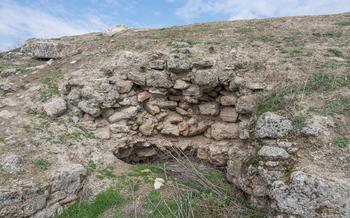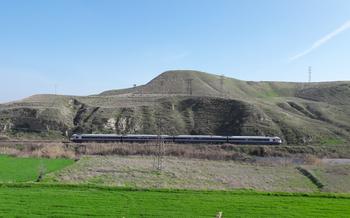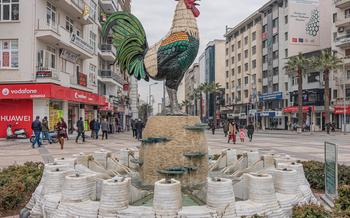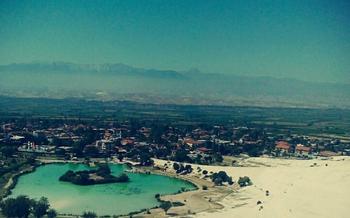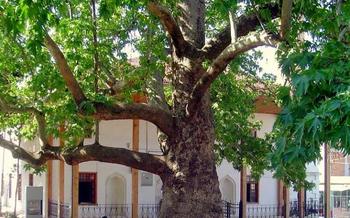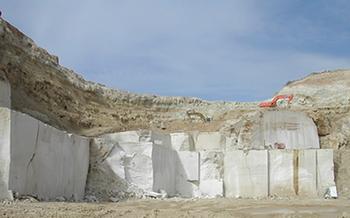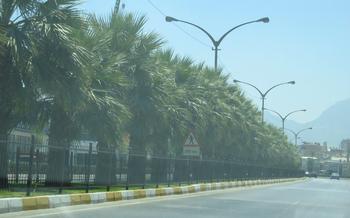
Beycesultan Mound
- Historical Significance
- Archaeological Findings
- City Layout
- Religious and Cultural Center
- Beycesultan Museum: Unveiling Ancient Treasures
- Guided Tours
- Best Time to Visit
- Getting There
- Admission and Fees:
- Duration of Visit
- Accessibility
- Facilities
- Photography
- Respect and Preservation
- Insider Tip: Explore Beyond Beycesultan
Historical Significance
Beycesultan, an archaeological treasure trove, invites you to journey back in time and unravel the captivating history of the ancient city. As you step through its gates, you'll be transported to the Bronze Age, an era of remarkable civilizations that shaped Anatolia's rich heritage. Discover the secrets of this once-thriving metropolis, where people built, traded, and thrived, leaving behind a legacy that continues to inspire and intrigue. Explore the intricate connections between Beycesultan and other Anatolian settlements, shedding light on the cultural exchange and interactions that shaped the region's destiny.
Archaeological Findings
Beycesultan has yielded a wealth of archaeological treasures that provide a glimpse into the lives of its ancient inhabitants. Excavations have unearthed a vast array of artifacts, including pottery, tools, weapons, jewelry, and religious objects. These artifacts offer insights into the daily life, customs, and beliefs of the Bronze Age people who called Beycesultan home.
Among the most notable finds are the clay tablets inscribed with cuneiform script, which shed light on the administrative and economic systems of the city. The tablets reveal that Beycesultan was a major trading center, with connections to other Anatolian settlements and even distant lands.
The excavations have also uncovered the remains of workshops and kilns, indicating that Beycesultan was a center of craft production. The artisans of Beycesultan were skilled in pottery, metalworking, and weaving, and their products were highly sought after throughout the region.
The archaeological findings at Beycesultan provide a tangible connection to the past, allowing visitors to experience the rich history and culture of this ancient city.
City Layout
Beycesultan's well-preserved city walls, gates, and streets provide a glimpse into the urban planning and architectural principles of the ancient city. Explore the different districts and neighborhoods, each with its own unique character. Discover the intricate network of streets and alleys, lined with the remains of houses, shops, and public buildings. Marvel at the impressive city gates, which once served as the main entrances to the city and provided protection from invaders.
Religious and Cultural Center
Beycesultan was not just a political and economic hub; it was also a significant religious and cultural center. The city's temple complex, with its impressive architecture and intricate carvings, stands as a testament to the spiritual beliefs of its ancient inhabitants. Here, rituals and ceremonies were performed to honor various deities, and the community gathered to celebrate religious festivals.
Explore the temple's well-preserved chambers, each dedicated to a specific god or goddess. Discover the remnants of altars, offerings, and inscriptions that provide glimpses into the religious practices of the Bronze Age. The temple's design and iconography reveal influences from neighboring cultures, highlighting the interconnectedness of ancient Anatolian civilizations.
Beyond the temple complex, evidence of cultural exchange and artistic influences is evident throughout Beycesultan. Imported pottery, jewelry, and other artifacts suggest vibrant trade networks and the exchange of ideas with distant regions. The city's architecture, with its distinct features and decorative elements, showcases the creativity and artistic prowess of its people.
As you wander through the ruins of Beycesultan, let your imagination transport you back to a time when the city was a vibrant center of religious devotion, cultural expression, and artistic innovation.
Beycesultan Museum: Unveiling Ancient Treasures
The Beycesultan Museum, situated within the archaeological site itself, serves as a treasure trove of artifacts that bring the ancient city's history to life. As you step inside, you'll be greeted by a captivating collection of pottery, tools, weapons, and jewelry, each meticulously preserved and displayed. These artifacts, excavated from the city's ruins, provide a tangible connection to the daily lives, customs, and beliefs of its inhabitants.
One of the highlights of the museum is the impressive collection of pottery. Ranging from simple utilitarian vessels to intricately decorated ceremonial pieces, these ceramic artifacts offer insights into the craftsmanship and artistic expression of the Bronze Age people. You'll marvel at the intricate designs and motifs that adorn these vessels, reflecting the cultural and aesthetic sensibilities of the era.
Alongside the pottery, the museum showcases an array of tools and weapons that shed light on the technological advancements and subsistence strategies of the ancient Beycesultan inhabitants. From bronze daggers and arrowheads to stone tools and agricultural implements, these artifacts provide a glimpse into the practical aspects of daily life in the city.
Jewelry, a testament to the artistry and personal adornment of the Bronze Age people, is another highlight of the museum's collection. Exquisitely crafted necklaces, earrings, bracelets, and rings made from gold, silver, and semi-precious stones showcase the skill and creativity of ancient artisans. These ornaments not only served as personal adornment but also held cultural and symbolic significance, reflecting the social status and beliefs of their wearers.
The Beycesultan Museum is not merely a repository of artifacts; it's a gateway to understanding the lives, culture, and achievements of the ancient inhabitants of Beycesultan. Through its diverse collection, the museum offers a glimpse into the rich tapestry of this Bronze Age city, providing visitors with a deeper appreciation for its enduring legacy.
Guided Tours
Enhance your understanding of Beycesultan's rich history and significance by taking advantage of guided tours. Knowledgeable guides will lead you through the ancient city, providing insights and answering your questions. They can customize your tour to focus on specific aspects of Beycesultan's history, culture, or architecture. Whether you're a history buff, an archaeology enthusiast, or simply curious about ancient civilizations, a guided tour will deepen your appreciation for this remarkable site.
Best Time to Visit
Timing is essential when planning a visit to Beycesultan. To ensure the most enjoyable experience, consider the following recommendations:
-
Spring (April-May) and Fall (September-October): These seasons offer pleasant weather, with mild temperatures and fewer crowds. The weather is ideal for exploring the ruins and wandering through the site without feeling overwhelmed by heat or crowds.
-
Summer (June-August): While summer offers longer days and more sunshine, it can also bring scorching heat, especially during midday. If you're prone to heat sensitivity, it's best to avoid visiting during this time.
-
Winter (November-March): Winters in Denizli can be cold and rainy, making it less ideal for exploring an outdoor site like Beycesultan. However, if you're prepared for the weather and don't mind the cold, you may enjoy the tranquility of the site during this time.
-
Weekdays vs. Weekends: Weekends tend to attract more visitors, especially during the summer months. If you prefer a quieter and more relaxed experience, consider visiting Beycesultan on a weekday.
Getting There
Reaching Beycesultan is a breeze, whether you choose to drive or take public transportation from Denizli. The journey offers stunning countryside views, making it a delightful experience in itself. For the ultimate flexibility and freedom to explore the surrounding area, consider renting a car. This way, you can set your own pace and discover hidden gems off the beaten path. Embrace the adventure and immerse yourself in the beauty of the Turkish countryside as you make your way to Beycesultan, a journey that promises to be as memorable as the destination itself.
Admission and Fees:
Before embarking on your journey to Beycesultan, it is essential to be informed about the admission fees and hours of operation. The current admission price grants you access to the archaeological site and the on-site museum. To ensure a budget-friendly experience, inquire about discounted rates for students, seniors, and families. Additionally, consider purchasing a museum pass that offers entry to multiple historical sites in the region, providing exceptional value for your travel investment.
Duration of Visit
Allocate at least 2-3 hours to fully explore Beycesultan and its museum. Take your time to wander through the ruins, read the informative signs, and absorb the atmosphere. Beycesultan is a vast site, and there's much to see and learn. Rushing through your visit will prevent you from fully appreciating its significance and beauty.
Consider bringing a packed lunch or snacks to enjoy during your visit, as there are no food options available on-site. This will allow you to maximize your time exploring and minimize any disruptions. Remember to stay hydrated, especially during the warmer months, and take breaks as needed to rest and soak in the ambiance of this ancient city.
Accessibility
Visitors with mobility issues should be aware that the terrain at Beycesultan is uneven and may pose challenges. Some areas, particularly within the ancient ruins, may not be wheelchair accessible. It is advisable to plan your visit accordingly and consider using a walking stick or sturdy shoes for added support. If you have concerns or require assistance, it is recommended to contact the site authorities in advance to inquire about accessible routes and facilities.
Facilities
Beycesultan is a site with limited facilities, so it's essential to come prepared. Since there are no facilities on-site, use the restrooms before your visit. The arid climate of the region demands that you bring an adequate water supply, especially during the summer months. Sunscreen and a hat are indispensable for protection against the sun's intense rays. Wear sturdy shoes or consider using a walking stick for added support, as the terrain can be uneven and challenging for visitors with mobility issues.
Photography
Capture the beauty of Beycesultan with your camera and immortalize your visit to this ancient city. Take panoramic shots of the sprawling ruins, capturing the grandeur of the city walls, the intricate details of the buildings, and the picturesque landscapes that surround the site. Don't miss the opportunity to photograph the unique rock formations, which add a touch of mystery and wonder to the overall scenery. Respect the rules and guidelines regarding photography at the site, ensuring that you don't disturb other visitors or damage any of the artifacts or structures. Your photographs will serve as a lasting reminder of your journey through time at Beycesultan.
Respect and Preservation
As you explore Beycesultan, remember that you are walking through a place of immense historical significance. Show respect for the site and its heritage by staying on designated paths and refraining from touching or damaging the ruins. Every artifact, every stone, every wall holds a story, and it is our collective responsibility to preserve this legacy for future generations. Avoid littering and dispose of your trash responsibly. By respecting Beycesultan, we can ensure that its treasures remain intact for years to come.
Insider Tip: Explore Beyond Beycesultan
Enrich your historical journey by combining your visit to Beycesultan with a trip to the nearby ancient city of Hierapolis and the breathtaking natural wonder of Pamukkale.
Located just a short distance from Denizli, Hierapolis offers a fascinating glimpse into the Roman and Byzantine past, with well-preserved ruins, including a theater, temples, and a necropolis.
After exploring the ancient city, don't miss the chance to marvel at Pamukkale, a unique natural formation consisting of cascading terraces of white travertine. Take a dip in the mineral-rich pools, relax amidst the stunning scenery, and let the healing waters soothe your body and soul.
This combined trip will provide you with a comprehensive historical and cultural experience, allowing you to delve deeper into the rich heritage of Turkey's Denizli region.
